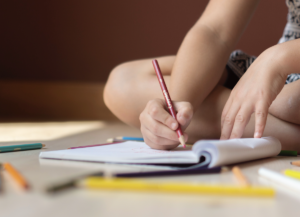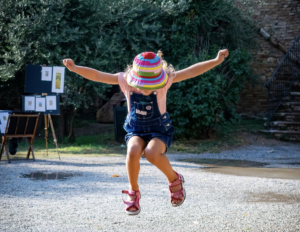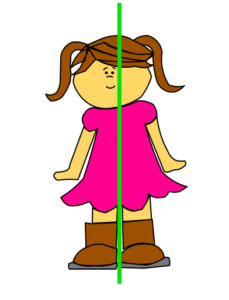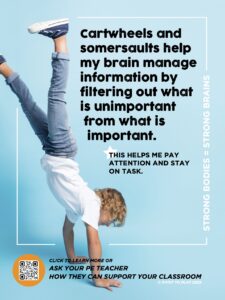Children need two kinds of play. When we grown-ups were in grade school, we called it recess and PE. In preschool, they have lots of names for it like playground time or outdoor time which, the equivalent of recess and movement, motor development or creative movement time the equivalent to PE. But they are both equally important to a child’s development.
Unstructured play has put together a really good PR team recently, bringing it to the forefront of preschool teacher conversations and headlining topics at preschool conferences. And let’s be honest, where previous generations got home from school, had a snack and were sent to play outside for hours on end, this doesn’t happen regularly today, so unstructured play needed a re-brand and a new marketing team.
Sadly, the burden for unstructured play continues to fall on teachers and is expected to happen during school time, putting pressure on an already stretched daily schedule. But it should not be a replacement for structured play. Structured play serves a vital developmental purpose and cannot be replaced or swapped out for other forms of play.
Structured Play
At Pivot to Play® and Pop, Hop & Rock™ we are really, really good at structured play. Our curriculum, our games and our activities have specific goals, allow for assessments and opportunity to strengthen weaknesses. We work on helping kids develop key strengths and skills they will need for classroom success. Some games focus more on core strength while others work on crossing the midline, aerobic strength, or grip strength. But with each activity we are given a chance to see where kids are in the continuum of developing their physical foundation. If we see children who are lagging behind, then we have an opportunity to develop a plan to help him get where he should be. For example:
- We ask children to jump and hop a lot. If a 5 year old is still struggling with this skill, jumping with his feet split, or not getting very much clearance off the floor, or failing to land on a target, then he could have a weak core, poor balance, underdeveloped perceptual motor skills like temporal awareness, or a sensory challenge.
- We like to watch kids run. By age 5 their gait should be even, smooth and easy to execute. When we see halting gaits, dragging feet or unsteady bodies, we worry about their balance, core and lower body strength, underdeveloped perceptual motor skills, as well as sensory challenges.
- We also like to have kids run because running is aerobic and we know that aerobic movement causes the brain to grow, it is like fertilizer for the brain. And when kids tell us they are tired, more often than not they are lacking appropriate aerobic capacity or they are weak in another area.
We want to catch these weaknesses and struggles early. If we don’t catch them early, then they are more pronounced as the child grows which leads to struggles in elementary school. These struggles range from a lack of confidence on the playground, difficulties following directions and paying attention to reading, writing and math challenges.
Unstructured play
Unstructured play should consist of several consistent factors:
- It should be primarily outdoors
- It should be almost exclusively self-directed
- It should be in all kinds of weather and temperature
- It should involve interesting items aka junk
- It should allow age appropriate risk
It is from this kind of play that we develop an internal sense of control, and that internal sense of control limits our risk of anxiety and depression. It allows us to develop confidence in what we can do, what our bodies can do and our decision making and risk taking.
We adults developed these skills when we judged
- Whether we should climb a little higher in a tree
- Whether we could jump out of the swing (and I mean the swings with the really long chains)
- Whose hands we should run through in Red Rover
- Whether we could make it to the can before getting tagged in kick the can.
- Whether our fort we were building could support the new branch
These skills are all transferred to the classroom and then to adulthood when we judge whether to take a risk by offering a suggestion to our colleagues at work, the risk of being turned down. The risk of asking someone on a date or getting in a car to drive. These are all calculated risks. But we learned how to take them by playing as children.
Unstructured, self directed play also helps kids develop critical social skills. For example the art of fort building helps a child learn to operate in a community for a desired result.
This community requires him to be
- The leader sometimes and the follower sometimes as he is making the decision for the group or allowing someone else to make the decision and allows him to learn the difference in these skills
- When that doesn’t work out, he will practice his negotiating skills and use his ability to interpret body language and other verbal and non-verbal cues.
In order for the building to continue he will have to practice
- Sharing,
- Cooperation and
- Collaboration
And on the way he will tap into his imagination and problem solving and goal setting.
It is important to point out that not one of these skills can be learned from a worksheet, flashcard or computer.
What do we mean in all kinds of weather? The world looks very different in the rain or snow. There is mud to play in, or a snowman to build. Each of these provides its own unique lesson in STEM and math. When we get muddy or wet is it the end of the world? No. Children need to learn that there are bumps in the road and we get muddy (things don’t go our way, we might even lose our job) but it isn’t the end of the world.
When we play with our toys in different weather, they react differently. They move differently in the summer than in the winter. STEM hard at work again.
And what makes play space more interesting? Water, sand, real pots, pans, spatulas and spoons. wheelbarrows, 5 gallon buckets, bales of hay. We see it as junk. Children see this as magic.
Play is not one small part of the young child’s learning process, it is absolutely essential to the learning process. The more they get, the better off they are in the long run.
Photo by Clem Onojeghuo on Unsplash
Updated 11/27/23
Jumping and Logic Go Together Like Pease and Carrots
Though jumping and logic go together like peas and carrots, jumping is actually foundational to logic, while carrots are just fine without the peas. Jumping requires a key perceptual motor skill: temporal awareness, the internal understanding of rhythm and time…




